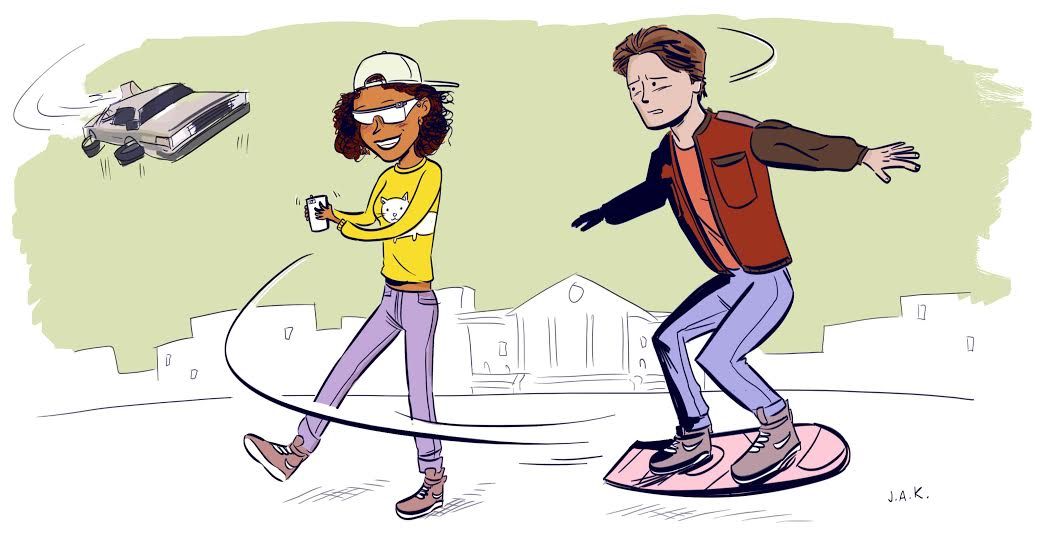
For as long as I can remember, my imagined vision of "life in the future" has centered around the year 2015.
That's not a year picked at random. That's thanks to one of cinema's most memorable depictions of the future: Back to the Future Part II, which was filling up theaters around this time in 1989. If you're rusty, that's the one where Marty McFly (Michael J. Fox) zips 30 years into the future to save his son from getting arrested, inadvertently setting in motion a chain of time-travel ripples that brings him back to a terrible, dystopian 1985. But there's nothing especially nightmarish about the movie's vision of 2015, which is a shiny, exciting world of hoverboards, flying cars and '80s future-chic.
Now that the real 2015 is not a week away, let's assess: How much did screenwriter Bob Gale, director Robert Zemeckis and the rest of the filmmakers get right? For an expert look at how the real 2015 will stack up with Back to the Future's fictional universe, Newsweek contacted a slew of influential futurists—scientists and thinkers who study and make predictions about the technologies of the future.
Here's who's who: Adrian Berry is a longtime science writer/editor for The Daily Telegraph and the author of The Next Ten Thousand Years: A Vision of Man's Future in the Universe and more than a dozen other books. Ross Dawson is founder of the think tank Future Exploration Network and author of the 2002 book Living Networks, which predicted the rise of social networks. Glen Hiemstra is a futurist speaker, consultant and the founder and owner of the site Futurist.com. Anne Lise Kjaer is a "future narrator" who is founder of the trend forecasting agency Kjaer Global and author of The Trend Management Toolkit: A Practical Guide to the Future. Syd Mead is a self-described "visual futurist" who notably designed set materials for sci-fi movies including Blade Runner (1982), Tron (1982) and Timecop (1994). And Michael Rogers is an author, MSNBC.com columnist and recent futurist-in-residence for The New York Times. Each futurist spoke to Newsweek in separate phone conversations, except for Rogers, who answered our questions by email.
Two caveats are necessary. First, as Zemeckis himself has acknowledged in the director's commentary on the film's DVD/Blu-Ray, the goal was to make a funny and entertaining film, not "to make a scientifically sound prediction that we were probably going to get wrong." So what? Any fictional envisioning of the future offers a glimpse of what present-day writers hope or fear might come true, and in this case the film did recruit a handful of future consultants to help with the predictions. They got more right than they probably expected.
Second thing is, we're not quite there yet. The Back to the Future sequel takes place primarily on October 21, 2015. In the journalistic interest of timeliness, we're jumping the gun a little bit. If things change dramatically in the next 10 months, we'll revisit this assessment. Hopefully we won't disrupt the space-time continuum as much as Marty.
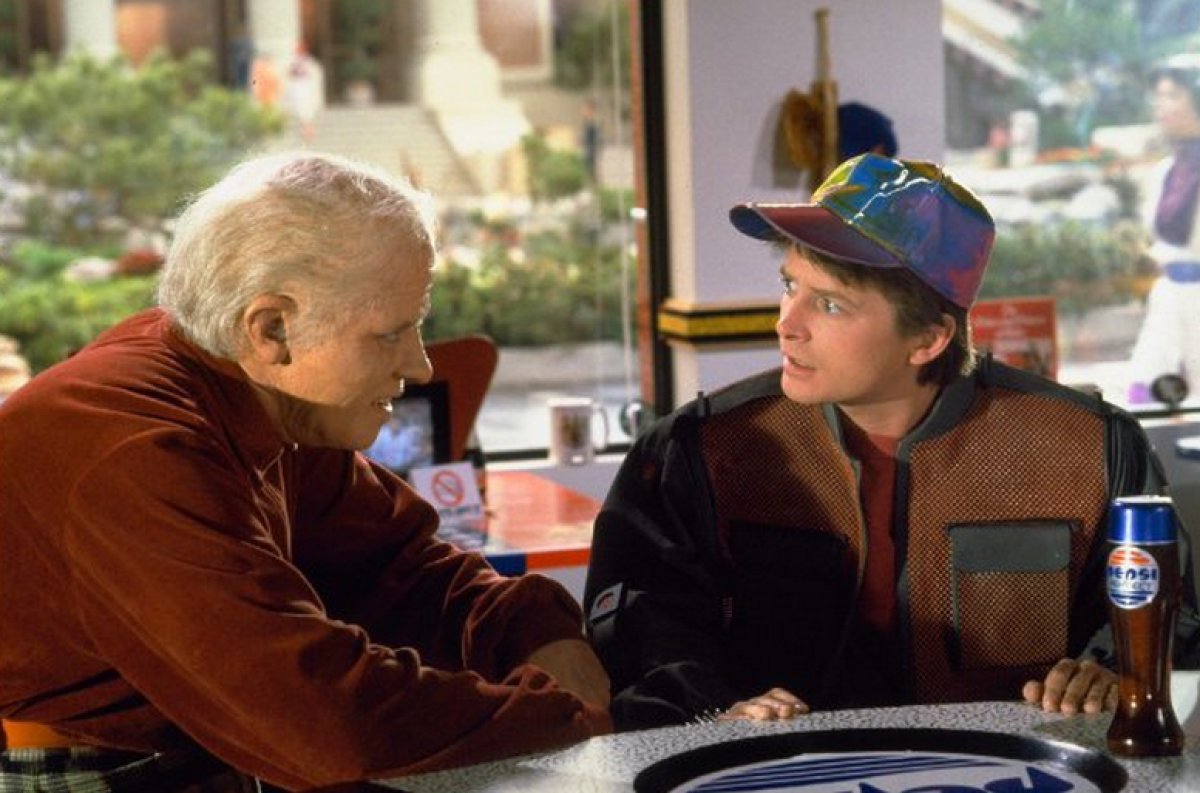
Some general thoughts on Back to the Future Part II from futurists:
Michael Rogers: One nice aspect of Back to the Future Part II was that the future (25 years ahead) wasn't a scary dystopia; it was actually a somewhat friendly, happy future with cool consumer goods. And many things hadn't changed, which is also a crucial point about the future (i.e., today there are still 1989 automobiles on the road, and we regularly fly in passenger planes even older than that).
Ross Dawson: The first point is it was never intended to be a serious film. I think a lot of what they were creating were inherently jokes of a certain kind. I do want to point out that we shouldn't take them as predictions but as things they thought would look good in a fictional film.
Anne Lise Kjaer: There is a time in the film where Doc says to Marty, "No one should know too much about their future." And I think that's very interesting. As a futurist, you know, we help companies in a way find out about the future. Then when he gets the almanac, this book tells the future. In a way, I thought it's a brilliant plot. Because why do we actually do future predictions, you know?
Syd Mead: They got most of it right in terms of what has been developed and came true. ... The future doesn't start from zero. They use streets and sets and things already existent. When you overlay a future onto a recognizable present, you're already halfway there already.
Michael Rogers: Of course, our actual 2015 may be a bit more threatening, with aspects like extreme weather and the increasing automation of jobs casting a shadow. Given those factors, I'm not sure that a Back to the Future III, set in 2040, could be quite as sunny. [Author's note: There is in fact a Back to the Future Part III, but it takes place further into the past, in 1885.]
Syd Mead: If you're designing for the movies, you've got to overlay a believable future onto a recognizable past. If you don't do that, you have to either interrupt the story and explain it or you lose the audience.
Anne Lise Kjaer: I heard the other day on the BBC, "History is a pack of lies told by people who were never there in the first place." And I thought, yeah, you could say the same thing about the future, right?
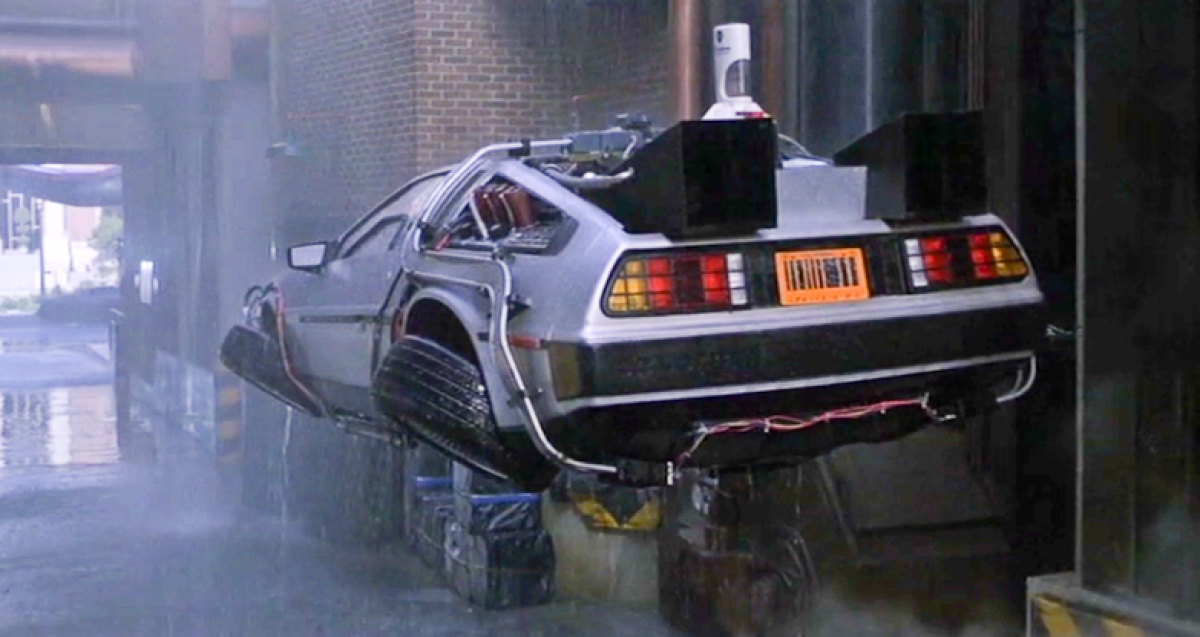
So when are we getting flying cars?
Michael Rogers: Futurists have been predicting flying cars almost ever since the car itself was invented. But the barriers are big. In terms of basic design, flying vehicles need lift; cars shouldn't have lift. In terms of driver skills, a car is basically two-dimensional navigation; an airplane is three dimensional. Big difference in the driving skill required. And finally, the FAA. Consider how cautious the regulators are being about drones, which weigh a few pounds and don't carry passengers. Multiply that caution by, oh, about a million, and that's how the regulators will respond to flying cars.
Adrian Berry: Well, they could happen. But I think the flying will be entirely computerized. You'll get a computer to fly it for you. It will be a self-flying car. Otherwise there would be so many accidents, because people are not very good at driving in two dimensions. As for driving in three dimensions, I think it's a recipe for disaster.
Ross Dawson: We do have flying cars. But not in the way they're portrayed in the film. [Dawson adds via email: Flying cars exist; see for example AeroMobil. But we don't yet have the highly manoeuvrable vehicles shown in the film.]
Adrian Berry: I've thought about them for years and years, but I think they're terribly dangerous for the whole population. As soon as you start driving the things yourself, there will be an awful lot of dead bodies falling out of the sky.
Glen Hiemstra: They got a lot right in terms of the overall feel of 2015. They have robot gas stations. We don't really have robot arms putting gas into your car, but we're pretty automated.
Anne Lise Kjaer: If you look at the pollution, they predicted [a] gloomy future which was very, very polluted. This was [after] you had the energy crisis in the '70s. The thinking was already there. They portrayed the future as very polluted. I think they got that right.

What about the hoverboards?
Michael Rogers: I've thought about the hoverboard a lot, and what it would require, basically, is anti-gravity technology. In 2015 we won't even have a complete theory of gravity.
Glen Hiemstra: Obviously the hoverboard was wrong. But there's a hoverboard company now. It uses magnetic repulsion. They're called Hendo Hoverboards. They have to be on a certain kind of metal surface. It's a company with big dreams of having a big impact in the warehousing and factory business, where you could move things around on big hoverboards. As of six months ago, we would've said, "Well, they got hoverboards wrong." But Hendo appeared in the past six months.
Ross Dawson: The reason people have been trying to create a hoverboard is that it was in the film and it captured people's imaginations. They weren't trying to predict the future, they were trying to create an interesting film, but I think it's interesting that everyone is saying "Where is my hoverboard" and now people are trying to create that. We discover what we want. Science fiction creates the desire for the technology that we see, which means that entrepreneurs can see if there is a desire and they then work hard to be able to create the technologies that we've discovered that we want.

On the food and kitchen technology of the future:
Glen Hiemstra: They're in his future house with his future self. And they make the pizza. And then a thing comes down out of the ceiling, which is a big garden thing that has fresh fruit and herbs and other vegetables in it. We do microwave a lot of things. You can go to any outdoor [camping supplies] store and get a pretty wide array of dehydrated food that isn't that far off from that small pizza.
Syd Mead: No, I don't remember [how the film depicted food]. I hope it wasn't pills. [laughs] That was a fixture in future films. Popping steak or spinach or whatever in a pill. I hope it never comes to that.
Ross Dawson: The dehydrated pizza ... I think this is an interesting point. I was saying before they were creating fiction. There was quite a lot they incorporated that was what people were anticipating. In the '80s, people were thinking about this idea of dehydrated food. This kind of portrayal of the future helps us to distinguish between the things we think are going to happen and then [decide] "I want that" or "I don't want that."
Syd Mead: Microwave dinners are bad enough. Of course, microwave upsets the molecular structure of food, which isn't too terribly healthy.

Let's talk about Back to the Future fashion.
Glen Hiemstra: There's the clothes that self-dry and automatically adjust in a big way to fit Marty. I'm surprised Dyson hasn't made a self-drying jacket of some kind with a little motor in it. That's one that technically you could say they got wrong.
Anne Lise Kjaer: Smart clothing is also very interesting because 2014 was the year of wearables. We had materials, we have smart materials that are already self-drying. ... Nike must have sponsored the film because there are so many Nike shoes. All the people are wearing trainers in 2015.
Glen Hiemstra: When Doc and Marty get up to 2015, Doc says, "Here, you gotta wear this jacket and turn your clothes inside out. That's the fashion today." Later the adult Marty in 2015 has this weird thing where he wears two neckties side by side. So they played with fashion a little bit.
Ross Dawson: They have video glasses. It's interesting that that is now coming into play with Google Glass and a number of other competitors.
Anne Lise Kjaer: All of this about voice control channel, multiple screens, then of course the Glass technology—they sit around the table and they have the eyewear already. And Skype and the digital pay system. We already have that now, right?
Ross Dawson: One of the things which, I suppose, epitomizes the film is the self-lacing shoes. I suppose part of the issue around that is, it seems like a good idea. But how are you going to pay for self-lacing shoes if it's an extraordinarily advanced technology when it's not that hard to lace yourself? Is it really worth developing self-lacing shoes as opposed to other things that could be more practical in our lives?
Adrian Berry: If you can make that [self-tying shoes] happen, that'd be great. I have a lot of trouble with shoes. But I don't think it's going to happen next year. I don't know if any manufacturer has got any plans for it.
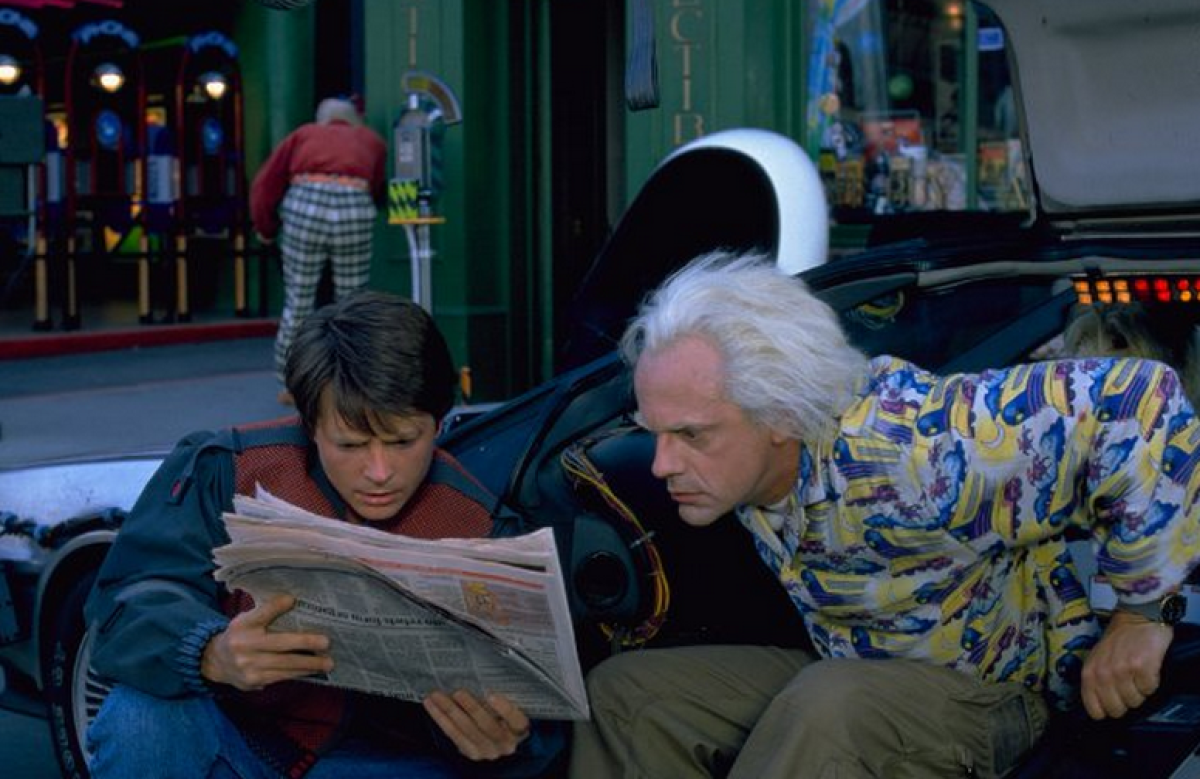
What else did the movie get horribly wrong?
Glen Hiemstra: The number one thing they got wrong was the dominance of fax machines in 2015. That's characteristic of a common forecasting pitfall, which is to overestimate the importance of something that is dominant in the current time. Fax machines were relatively new in the late '80s. So if you remember when Marty's getting fired, there's a fax coming in. And they refer to fax machines several times. Some time in the first 30 minutes, Marty and Doc walk past a U.S. postal service mailbox out on the street. It has a big computer terminal and a big sign that says "Fax here." Faxes are still around but they aren't in any way dominant.
Syd Mead: The fax machine was magic because you were transmitting pictures. That was magic back then. The Internet hadn't been invented, really. It was a military/technical link between research groups. So you can't imagine something that you can't imagine. It's a limitation of how we think and how we associate things with each other.
Ross Dawson: Another of the most prominent ones is the fusion device. Where you can get infinite energy from plutonium. That seems to be very different from where we are today.
Anne Lise Kjaer: The other one I took a note on was the use of rejuvenation face masks. Doc takes off his skin and he looks perfectly young. The idea of body obsession, body surgery—this is a culture that started there. It's obviously the whole movement of workout from the '80s has been in a way magnified. ... The early trends in the '80s are things projected into 2015.
Glen Hiemstra: In the first 30 minutes of the film or so, there's just one sight gag after another. Doc has been to a rejuvenation clinic where he has his spleen and colon replaced. We don't have anything like a rejuvenation clinic quite yet. There are various aging treatments you can take. ... Biff is really upset about his bionic implants short circuiting. It doesn't really say what the bionic implants do for him. But he actually sparks a couple of times. "My bionic implants are short-circuiting again." That isn't quite right.
Michael Rogers: It's interesting to note that the technology predictions that came true involve computers and electronics, the area in which it's easiest to make rapid progress. Big items—like cars—don't change nearly as fast.
Glen Hiemstra: One they got wrong is that there are phone booths everywhere. It's pretty hard to find these days. In fact it's really rare to see a phone booth.
Glen Hiemstra: The movie mentions that they had abolished lawyers by 2015. That has not happened. They got the Cubs winning the World Series. With the Cubs' new manager, maybe that'll come through. They never won the World Series. But they have hopes for 2015.
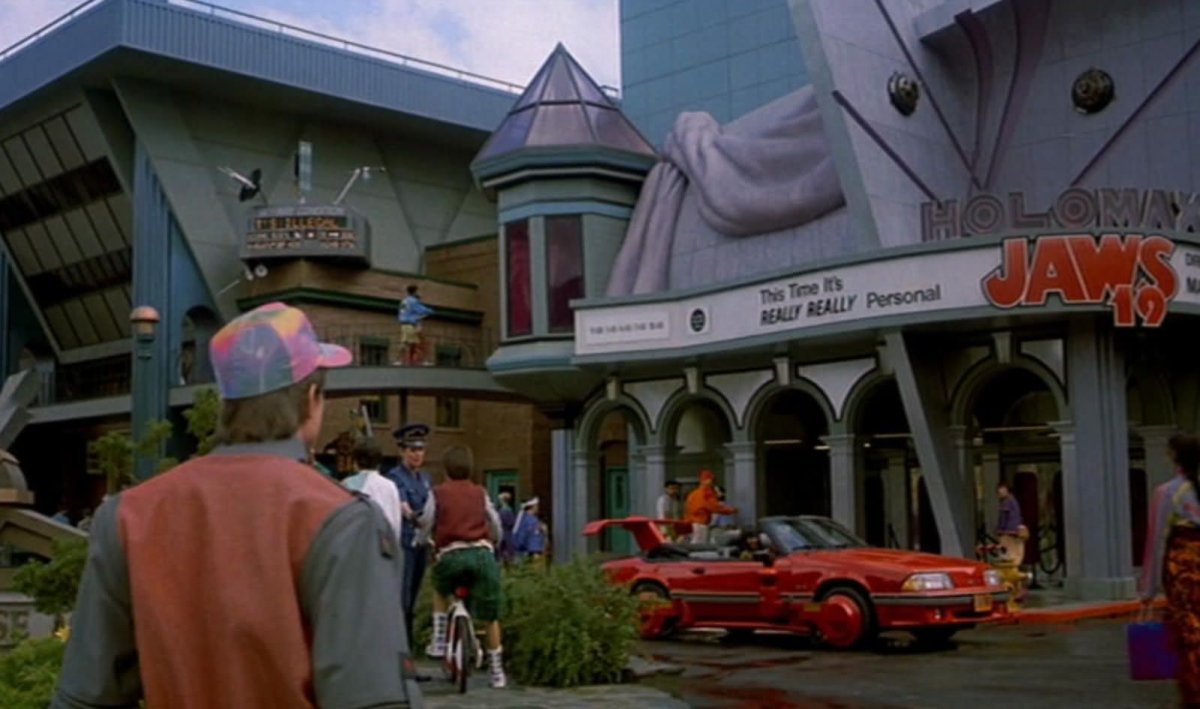
Any other unexpected things they got right?
Glen Hiemstra: If you remember, they go into a 1980s nostalgia cafe and there's people all dressed up in 1980s clothes and they're playing video games and young Marty picks up a video game controller and starts playing a shooter game with a handheld device and a couple of kids come up and say, "What are you doing? You use your hands?" They got right that we have gesture-based computing now, whether it's touch screen or just waving your hands at things. The Jaws 3-D movie promo is pretty right. We have 3-D everywhere.
Michael Rogers: One other great prediction: Old electronics had become antiques in 2015. A couple of weeks ago, an Apple I from the mid-'70s sold at auction for $360,000. Don't ditch that 1984 Mac yet!
Anne Lise Kjaer: Then of course there's the flat tablet and the iPhone-style camera. The guy is taking photographs of everything. What we see there is something that is also going to be really big: NFC, "near-field communication." The little chip? We have it in London, which is called the Oyster card. By late 2015 or 2015, we will have NFC phones. You can even pay with your phone. You don't need an Oyster card.
Michael Rogers: Three definite hits: biometrics, large screen home displays, video telephone calls. Skype and Facetime are part of everyday usage; by the end of the decade I think it will be totally natural for younger users to transition from text to audio to video in a single call, depending on the content at the moment.
Glen Hiemstra: This is one that probably no one else in these articles will mention. Partway through the film, they go out to Marty's house, where he lives. Young Marty is very excited because they live in Hilldale, because that was the upscale fancy place to live in the old days. But when he gets there, he finds out it's a slum. And it's really fallen on economic hard times and the sign in the entrance is all dilapidated. There's a little indication that there's a little affluence moving toward cities and away from suburbs. I bet they never really expected to get that right.
Michael Rogers: Thumbprints as IDs are already here—laptops, iPhone 6. My prediction is that by the end of this decade we will all have legal identities, somewhat like passports, on the Internet that are verified by a biometric—a thumbprint, palmprint, possibly an iris scan.
Ross Dawson: One thing that I think is interesting is the holographic billboard. There are a couple of technologies which appear to be close to giving us a holographic representation, including a company called Magic Leap. We all want more immersive entertainment. This kind of holographic movie—it seems like something we would want, we would pay for, and it seems like we are getting close.
Glen Hiemstra: The thing they got really right was big flat wall screens everywhere that you could talk to. Those pretty much didn't exist in the late '80s. There were no flat screens!
Michael Rogers: Large screen displays. Consider that a 24" LCD television cost $3,000 in 2005, and now costs about $159. Fifty-five-inch screens are becoming the norm in many households and with new manufacturing technology, the wall-size screen will be quite doable by the early '20s.
Anne Lise Kjaer: Of course, when they did this film, the Internet wasn't big. They have all the right ideas, with the flat tablet, the thumb print biometric. All of that will be done through the Internet of Things. Smart clothing as well. You will be wearing healthy, healing clothing. It will go through the Internet of Things. I call it the "Global Brain."
Glen Hiemstra: Drones are in the news. When the Christmas season is analyzed, drones will be one of the Christmas gift items of the year. But my favorite scene with the robotic drone in the film is, there's a drone that's walking a dog. Doesn't look that different from the little quadcopters you could buy at RadioShack now. We don't have dog-walking drones yet, but we may not be that far from it.
Anne Lise Kjaer: A lot of these things, it's also about ethics—how far can you go? All the things that you see in the film—it's all possible, and we're seeing it today. We have all the technology, but we also have another thing: How deep do we want to go? Now that they're there, do we really want them? It really is a film that, even though it's very commercial, it does bring a lot of things to the forefront.
Correction: An earlier version of this article misspelled the name of the planned community in Hill Valley. It is Hilldale, not Hillsdale. An earlier version of this article also failed to identify Glen Hiemstra as the founder and owner of Futurist.com.
Uncommon Knowledge
Newsweek is committed to challenging conventional wisdom and finding connections in the search for common ground.
Newsweek is committed to challenging conventional wisdom and finding connections in the search for common ground.
About the writer
Zach Schonfeld is a senior writer for Newsweek, where he covers culture for the print magazine. Previously, he was an ... Read more
To read how Newsweek uses AI as a newsroom tool, Click here.








